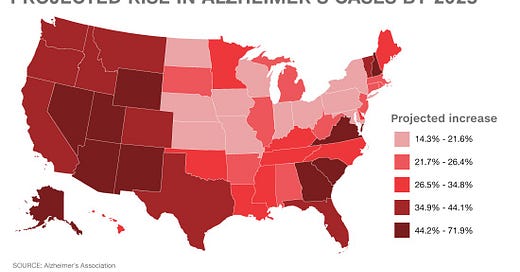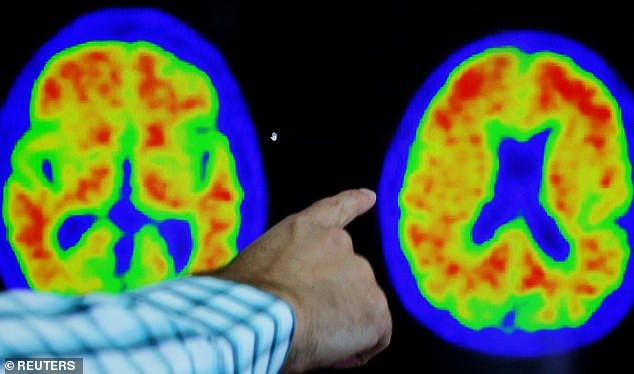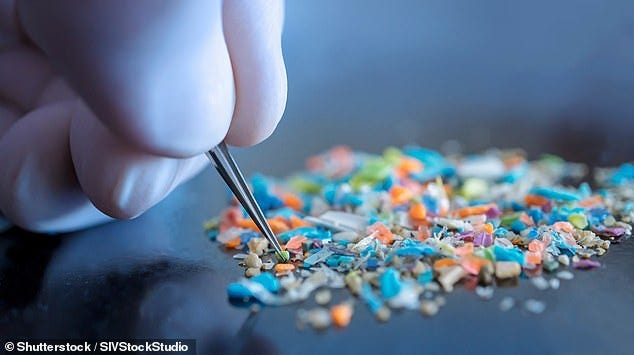The Hidden Ingredient in your Food and Clothes that Explains the Rise of Dementia in the United States
Alzheimer's disease is the most common cause of dementia, accounting for 60-80% of dementia cases. So, while Alzheimer's is a type of dementia, not all dementia is Alzheimer's!
By OSHEEN YADAV
May 21, 2025
Scientists have made a startling study in the human brain that could be fueling the rise of dementia in the United States.
We've been waiting for this breakthrough on Alzheimer's for 30 years
PET scan shows evidence of Alzheimer's disease
A breakthrough discovery had been made a few years earlier, identifying a protein called amyloid beta that forms clumps – known as plaques – that disrupt the brain's function and kick off a cascade that causes cognitive decline.
But instead of that discovery leading quickly to an effective treatment for Alzheimer's, we saw trial after trial of new drugs end in failure.
Meanwhile, as the population aged, more patients were shattered by the devastating impact of the disease, and we could offer them no hope.
Hands of a resident at a nursing home. Donanemab was hailed as a 'turning point' in the fight against Alzheimer's.
Today, the picture is different. A new drug, donanemab, targets these plaques and prompts the body to produce an immune response.
It has been shown to slow the progression of Alzheimer's disease by around 30 per cent over a 72-week trial.
Some participants, with early stage degeneration, had a greater slowing of cognitive decline compared with the placebo group.
The neuroscience community has been waiting for a breakthrough like this for 30 years. And it comes just weeks after another new drug, lecanemab – shown to slow progression of early-stage Alzheimer's symptoms by 27 per cent by targeting amyloid plaques – was approved for use in the US.
They analyzed brain tissue from 54 autopsies, discovering that every sample contained microplastics, equivalent in mass to an entire plastic spoon.
Microplastics are small plastic pieces that are less than 5mm in size and insoluble in water. They are harmful for environment and lead to plastic pollution.
These tiny particles can accumulate in the body, with prior research linking them to various forms of cancer—including skin, breast, cervical, and colorectal—as well as testicular cancer, Alzheimer’s disease, and dementia.
Cancer-causing microplastics are found in 100% of men's testicles in new study
The researchers found that individuals diagnosed with dementia exhibited up to ten times more microplastics in their brain tissue compared to those without this condition.
Although the study does not directly connect them, it does show a relationship between the accumulation of microplastics and neurological disorders.
Lead author Professor Matthew Campen of the University of New Mexico emphasized the urgency of understanding how these particles penetrate the brain’s protective barriers—and what damage they may cause over time.
'I never would have imagined it was this high,' he said.
In a groundbreaking study, researchers analyzed brain tissue from 28 autopsies in 2016 and 26 in 2024, discovering that every sample contained microplastics, equivalent in mass to an entire plastic spoon.
Professor Campen, a toxicologist, said microplastic levels in the human brain have increased by 50 percent over the past eight years, mirroring the global rise in plastic pollution.
To investigate this trend, Campen's team analyzed brain tissue samples provided by the New Mexico Office of the Medical Investigator, which is legally required to retain autopsy tissue for seven years before disposal.
The samples were taken during autopsies in 2016 and 2024.
All samples were taken from the frontal cortex—the brain region located above and behind the eyes, Campen noted.
To isolate microplastics, the tissues were dissolved using a specialized chemical process that left behind a pellet of undissolved material.
This pellet was then heated, allowing researchers to capture the gas emissions released as the plastics burned.
Using this technique, the team detected and measured 12 different plastic polymers. The most common was polyethylene, a material widely used in packaging and containers such as bottles and cups.
On average, the brain tissue contained about 4,800 micrograms of microplastic per gram —roughly equivalent to the weight of a plastic spoon.
Researchers also discovered clusters of sharp plastic shards measuring 200 nanometers or smaller—not much larger than some viruses.
Microplastics are small plastic pieces that are less than 5mm in size and insoluble in water. They are harmful for environment and lead to plastic pollution.
Microplastics—especially nanoplastics—can cross the blood-brain barrier, a protective shield that typically prevents harmful substances from entering the brain.
Once inside, these tiny particles may trigger inflammation, disrupt neurological signaling, and potentially contribute to the development of neurological disorders.
While scientists are still investigating the direct impact of microplastics on human health, animal studies have shown that exposure can lead to behavioral changes, memory impairment, and reduced motor coordination.
Dr Gary Small, chair of psychiatry at Hackensack University Medical Center, emphasized that current findings in relation to dementia do not prove a causal relationship, but they are still cause for concern.
The most common plastics identified in brain samples were polyethylene and polypropylene, materials widely used in packaging, containers, and everyday consumer goods.
These particles most likely enter the body through contaminated food and beverages.
According to Professor Campen, the research team even found significant levels of microplastics in store-bought meat.
To that he added, 'The way we irrigate fields with plastic-contaminated water, we postulate that the plastics build up there.'
Over time, chemicals may accumulate in fields as a result of the feeding of crops to livestock and the fertilization of fields with their waste.
A study conducted by the Ocean Conservancy found that highly processed protein products—such as fish sticks, chicken nuggets, and plant-based burgers—contained significantly more microplastics per gram than minimally processed alternatives.
In response, health professionals recommend several strategies to reduce microplastic exposure.
These include using glass or stainless steel containers instead of single-use plastics, installing water purifiers, and choosing natural fibers over synthetic fabrics.
The study's findings have sparked growing calls for urgent action to limit microplastic exposure.
Advocates are also pushing for stricter regulations on plastic production and waste management to curb environmental pollution at its source.
The detection of microplastics in every human brain sample analyzed underscores the widespread reach of plastic pollution—and its potential implications for human health.
READ MORE:
1 in 2 Americans May Face Dementia Risk–Here’s What You Need to Know
The 10 foods high in cancer-causing microplastics... and 'the easy swaps' to avoid them
Written Off: The Consequences of Dementia Misdiagnosis
Vitamin D Deficiency Linked to Higher Risk of Early-Onset Dementia
Your support is crucial in exposing fake news and in helping us defeat mass censorship.










This MUST be an error: "less than 5mm"
you meant 5 MICRONS, right?!
5 µm is what you need to place here. . .
(5mm is about 1/4"!)
Do you know if Celestial Seasonings teabags contain micro plastics?